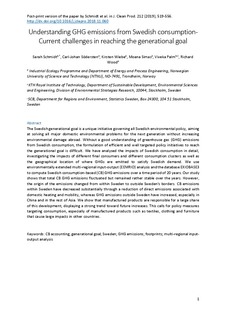| dc.contributor.author | Schmidt, Sarah | |
| dc.contributor.author | Södersten, Carl-Johan | |
| dc.contributor.author | Wiebe, Kirsten Svenja | |
| dc.contributor.author | Silva Simas, Moana | |
| dc.contributor.author | Palm, Viveka | |
| dc.contributor.author | Wood, Richard | |
| dc.date.accessioned | 2019-06-17T08:54:05Z | |
| dc.date.available | 2019-06-17T08:54:05Z | |
| dc.date.created | 2018-12-19T12:43:52Z | |
| dc.date.issued | 2019 | |
| dc.identifier.citation | Journal of Cleaner Production. 2019, 212 (1), 428-237. | nb_NO |
| dc.identifier.issn | 0959-6526 | |
| dc.identifier.uri | http://hdl.handle.net/11250/2600951 | |
| dc.description.abstract | The Swedish generational goal is a unique initiative governing all Swedish environmental policy, aiming at solving all major domestic environmental problems for the next generation without increasing environmental damage abroad. Without a good understanding of greenhouse gas (GHG) emissions from Swedish consumption, the formulation of efficient and well targeted policy initiatives to reach the generational goal is difficult. We have analysed the impacts of Swedish consumption in detail, investigating the impacts of different final consumers and different consumption clusters as well as the geographical location of where GHGs are emitted to satisfy Swedish demand. We use environmentally extended multi-regional input-output (EEMRIO) analysis and the database EXIOBASE3 to compute Swedish consumption-based (CB) GHG emissions over a time period of 20 years. Our study shows that total CB GHG emissions fluctuated but remained rather stable over the years. However, the origin of the emissions changed from within Sweden to outside Sweden's borders. CB emissions within Sweden have decreased substantially through a reduction of direct emissions associated with domestic heating and mobility, whereas GHG emissions outside Sweden have increased, especially in China and in the rest of Asia. We show that manufactured products are responsible for a large share of this development, displaying a strong trend toward future increases. This calls for policy measures targeting consumption, especially of manufactured products such as textiles, clothing and furniture that cause large impacts in other countries. | nb_NO |
| dc.language.iso | eng | nb_NO |
| dc.publisher | Elsevier | nb_NO |
| dc.rights | Attribution-NonCommercial-NoDerivatives 4.0 Internasjonal | * |
| dc.rights.uri | http://creativecommons.org/licenses/by-nc-nd/4.0/deed.no | * |
| dc.title | Understanding GHG emissions from Swedish consumption - Current challenges in reaching the generational goal | nb_NO |
| dc.type | Journal article | nb_NO |
| dc.type | Peer reviewed | nb_NO |
| dc.description.version | acceptedVersion | nb_NO |
| dc.source.pagenumber | 428-237 | nb_NO |
| dc.source.volume | 212 | nb_NO |
| dc.source.journal | Journal of Cleaner Production | nb_NO |
| dc.source.issue | 1 | nb_NO |
| dc.identifier.doi | 10.1016/j.jclepro.2018.11.060 | |
| dc.identifier.cristin | 1645582 | |
| dc.description.localcode | © 2018. This is the authors’ accepted and refereed manuscript to the article. Locked until 22.11.2020 due to copyright restrictions. This manuscript version is made available under the CC-BY-NC-ND 4.0 license http://creativecommons.org/licenses/by-nc-nd/4.0/ | nb_NO |
| cristin.unitcode | 194,64,25,0 | |
| cristin.unitname | Institutt for energi- og prosessteknikk | |
| cristin.ispublished | true | |
| cristin.fulltext | original | |
| cristin.qualitycode | 2 | |

